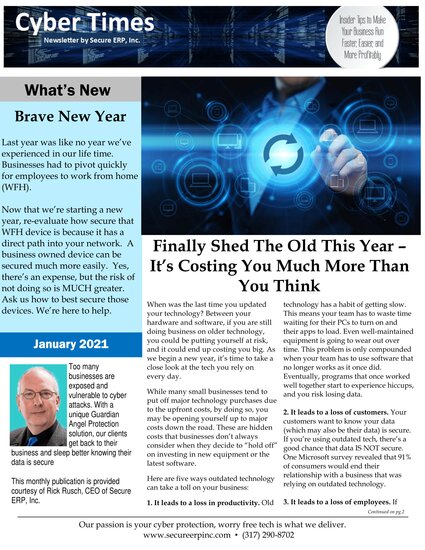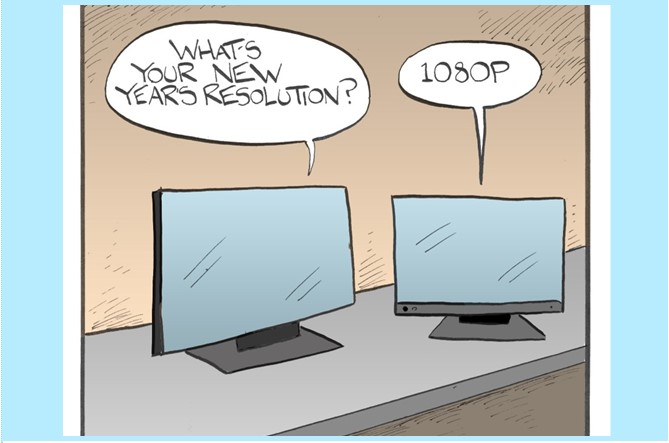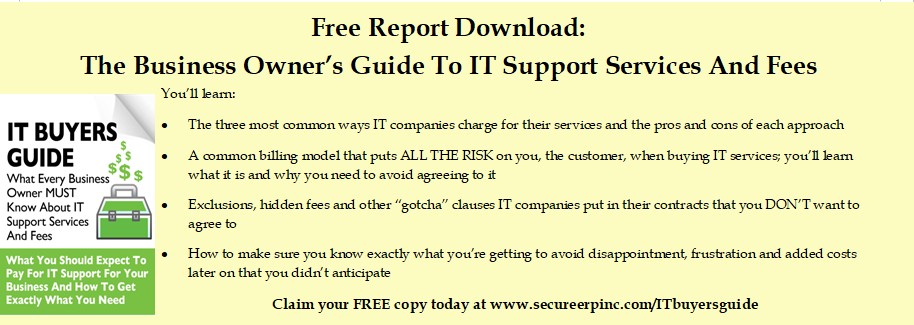
Brave New Year
Last year was like no year we’ve experienced in our life time. Businesses had to pivot quickly for employees to work from home (WFH).
Now that we’re starting a new year, re-evaluate how secure that WFH device is because it has a direct path into your network. A business owned device can be secured much more easily. Yes, there’s an expense, but the risk of not doing so is MUCH greater. Ask us how to best secure those devices. We’re here to help.
Finally Shed The Old This Year – It’s Costing You Much More Than You Think
 When was the last time you updated your technology? Between your hardware and software, if you are still doing business on older technology, you could be putting yourself at risk, and it could end up costing you big. As we begin a new year, it’s time to take a close look at the tech you rely on every day.
When was the last time you updated your technology? Between your hardware and software, if you are still doing business on older technology, you could be putting yourself at risk, and it could end up costing you big. As we begin a new year, it’s time to take a close look at the tech you rely on every day.
While many small businesses tend to put off major technology purchases due to the upfront costs, by doing so, you may be opening yourself up to major costs down the road. These are hidden costs that businesses don’t always consider when they decide to “hold off” on investing in new equipment or the latest software.
Here are five ways outdated technology can take a toll on your business:
1. It leads to a loss in productivity. Old technology has a habit of getting slow. This means your team has to waste time waiting for their PCs to turn on and their apps to load. Even well-maintained equipment is going to wear out over time. This problem is only compounded when your team has to use software that no longer works as it once did. Eventually, programs that once worked well together start to experience hiccups, and you risk losing data.
2. It leads to a loss of customers. Your customers want to know your data (which may also be their data) is secure. If you’re using outdated tech, there’s a good chance that data IS NOT secure. One Microsoft survey revealed that 91% of consumers would end their relationship with a business that was relying on outdated technology.
3. It leads to a loss of employees. If employees have to deal with slow hardware and poorly-integrated software every day, they’re going to get frustrated. They’re going to get even more frustrated if nothing is done about it. The end result is high employee turnover. This alone can be a huge cost for a small business to absorb.
 4. It leads to a loss of support. Over time, developers stop supporting their older products so they can focus on their new products. This also means they’re devoting more attention to the customers who are using the newer versions. This can leave you in the dark if you run into a problem that you need help with. You may have to call in a third-party specialist to answer your question and fix your problem, and they will charge you accordingly.
4. It leads to a loss of support. Over time, developers stop supporting their older products so they can focus on their new products. This also means they’re devoting more attention to the customers who are using the newer versions. This can leave you in the dark if you run into a problem that you need help with. You may have to call in a third-party specialist to answer your question and fix your problem, and they will charge you accordingly.
5. It leads to a loss of security. A loss in support also means you aren’t going to see security patches for your aging hardware or software. This makes you highly vulnerable to all kinds of cyberthreats, including data breaches, malware infections, and all kinds of other cyber-attacks. Hackers want to break into your network, and if you’re using outdated tech, you make their job much easier.
When you factor in the costs associated with these losses, it can be staggering! It’s enough to put some companies out of business (and it has). After a year that has left many businesses more vulnerable than before, you should be taking steps to avoid these kinds of losses.
Here’s what you can do: as we head into a new year, take stock of your technology. It’s unlikely you have to replace everything, but look at where you are most vulnerable. What issues are your employees experiencing? What hardware or software is no longer supported? Where are the gaps in your IT security?
The great news is that you don’t have to answer these questions on your own. Even better, you don’t have to drop a pretty penny to make it happen! You can work with a managed service provider (MSP) or a dedicated IT services firm that can help bring your business back up to speed. They can even help you mitigate some of the cost that comes with upgrading your technology. In the end, you, your employees, and your customers GAIN complete confidence in your business as you head into 2021!
MSP vs. MSSP
Who is Keeping Your Computer Safe?
If your answer is “My IT guy” don’t be so sure. Just like the medical industry, technology is moving to specialties. Would you ask a general doctor to perform heart surgery? No way, you want it done RIGHT the first time.
Today, to best protect your business you need a cybersecurity specialist. Your IT guy may be great at getting the most out of your PCs, but a security guy will want to do the most to reduce your RISK. Without working with a specialist you’ll be leaving gaps. These gaps are what cyber criminals count on to give them a big, fat payday (at your expense.
Ask for a 3rd party cybersecurity expert to review your current network, so you can manage those gaps and make better business decisions to preserve your cash.
In a quick 10 minute call, I can help you decide if you’d benefit from a more thorough examination of your cybersecurity defense. Can you afford skipping this 10 minute phone call?
Schedule a call today: https://go.scheduleyou.in/7amaCsd
Stop Recurring Problems
 Some of the biggest challenges with companies today are “RECURRING PROBLEMS.” I’m talking about situations, hassles and mistakes that happen over and over again and never get resolved. These occurrences are worse when they happen to customers because if they happen too often, customers will quit doing business with you. Consider what RECURRING PROBLEMS do to employees – frustration sets in, morale plummets and so do productivity and profits.
Some of the biggest challenges with companies today are “RECURRING PROBLEMS.” I’m talking about situations, hassles and mistakes that happen over and over again and never get resolved. These occurrences are worse when they happen to customers because if they happen too often, customers will quit doing business with you. Consider what RECURRING PROBLEMS do to employees – frustration sets in, morale plummets and so do productivity and profits.
I heard it once stated that recurring problems eat up more than 40% of the average productivity of a company. That may seem a bit high to you, but consider the fact that rarely is a problem just one person’s problem. The employee who discovers the problem will most likely get others involved in dealing with it. What they were originally doing will come to a halt, causing that productivity to be lost while a remedy is figured out.
To make this an even bigger problem, according to estimates based on a recent University of California Irvine study, refocusing your efforts after just one interruption can take up to 23 minutes. So, every time you come up with a quick fix, you are adding an additional 23 minutes of lost productivity with every occurrence.
Time, which is money, is a precious commodity that we can’t afford to waste. It is imperative to gather data on problems that are RECURRING and hassling employees and customers so you can address them. You want a process to be hassle-free, so get your employees involved in identifying recurring problems. Your employees are closest to the problem and can give you valuable insight into what is really going on. In turn, this will reduce costs, increase profits, and improve efficiency across the board.
The Ritz Carlton Hotels requires employees to log all incidences of customer or employee problems or concerns and turn them in daily. This information helps them make improvements that will save them time and money, improve working conditions and morale and increase customer satisfaction. A problem identified is a blessing because you can’t fix what you don’t know to be wrong. No company wants frustrated employees or customers, and a 40% loss in productivity is a scary statistic that needs to be addressed.
But understand this: do not start this process if you have no intention of following through on correcting the recurring problems. Be responsive to the issue identified and fix it. Eliminate RECURRING PROBLEMS and watch your morale go up, efficiencies improve, complaints go down and profits soar.
 Robert Stevenson is one of the most widely recognized professional speakers in the world. Author of the books How To Soar Like An Eagle In A World Full Of Turkeys and 52 Essential Habits For Success, he’s shared the podium with esteemed figures from across the country, including former President George H.W. Bush, former Secretary of State Colin Powell, Tony Robbins, Tom Peters and Stephen Covey.
Robert Stevenson is one of the most widely recognized professional speakers in the world. Author of the books How To Soar Like An Eagle In A World Full Of Turkeys and 52 Essential Habits For Success, he’s shared the podium with esteemed figures from across the country, including former President George H.W. Bush, former Secretary of State Colin Powell, Tony Robbins, Tom Peters and Stephen Covey.
A Scary New Threat To Your Network’s Security
More people are working remotely than ever before. Many businesses had to make a huge shift in 2020. At the same time, cybercriminals used the shift to attack as many people as possible. They knew that with more people working at home, there would be a window when cyber security wasn’t a priority – and they were right.
Because businesses had their hands full getting their teams set up for remote work, IT security slipped through the cracks. Cybercriminals used their greatest tool to their advantage. That tool? Human error. Hackers sent out phishing emails and attacks at an unprecedented rate. Infosecurity Magazine reports that phishing attacks increased upwards of 30,000% over the last year!
This highlights the need for strong IT security for the remote workforce. Remote workers must be trained up on the latest cyberthreats, especially phishing scams. They also need serious endpoint security on their at-home devices (such as antivirus software and other malware protection). If you need them to access your network, security MUST be in place, and that includes the use of a VPN. usecure, Oct. 8, 2020
The Very First Thing You Must Do This Year
Before you turn your attention to the big goals you’ve set for your business in 2021, there’s one very important thing you need to do ASAP: a cyber security audit. You need to know where you and your business stand against today’s many cyberthreats. An IT security assessment will tell you how capable you are of withstanding or blocking data breaches, malware infections and much more. When you know where the gaps are, you can fill them, giving your business the edge in 2021.
Is Reading On Your Resolution List? See Unexpected Reads From The Top CEO’s In 2020
If it’s time for a new reading list, look no further than some of the top reads from 2020, as picked by CEOs. Here are a few of their picks according to the online library, Perlego.
- The (Honest) Truth About Dishonesty: How We Lie To Everyone — Especially Ourselves by Dan Ariely: This is a book about cheating. Why do people do it? Does it have a purpose?
- How To Make Anyone Like You: Proven Ways To Become A People Magnet by Leil Lownde: This is a book with a self-explanatory title. The author walks readers through ways to get people on your side and how to better interact with others.
- Great Speeches Of The 20th Century by Bob Blaisdell: If you want to be inspired, look no further. This is a collection of speeches that captivated audiences at the time and in years following.
- The Shallows: How The Internet Is Changing The Way We Think, Read And Remember by Nicholas Carr: This book is a thoughtful look into current technologies and how they shape the way we think, form relationships and interact with the world. Business Insider, Sept. 1, 2020


 Contact Us At
Contact Us At



